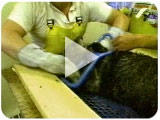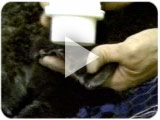Before cleaning, oiled sea otters should be examined by a veterinarian to determine whether they are healthy enough to tolerate the three-to-four-hour cleaning procedure. (See Chapter 4 for details about stabilization before cleaning.) Alert and active otters should be chemically restrained during cleaning. In general, heavily oiled sea otters should be washed as soon as possible to prevent further petroleum hydrocarbon exposure by dermal absorption or ingestion during grooming. Sea otters with light or patchy oil on their fur may benefit from a period of stabilization before washing (Chapter 11).
The cleaning process can be divided into six phases: 1) chemical restraint, 2) washing, 3) rinsing, 4) drying, 5) application of conditioners, and 6) recovery from sedation.
Chemical Restraint
Chemical restraint for sea otters during cleaning is described in Chapter 3. After light sedation, the otter is placed on a specially designed cleaning table (Figure 6.2) in the cleaning room and physically restrained by a trained animal handler. For hypothermic or very lethargic animals, chemical restraint is not recommended and mild physical restraint should be adequate. The handler grasps the otters skin behind the shoulder blades and maintains control over head movements. An ophthalmic ointment should be applied to the otter’s eyes to protect them from detergent and oil. During this time, a blood sample should be taken by a veterinarian or technician for hematology and blood chemistry analysis (see Chapter 4, Figure 4.1).
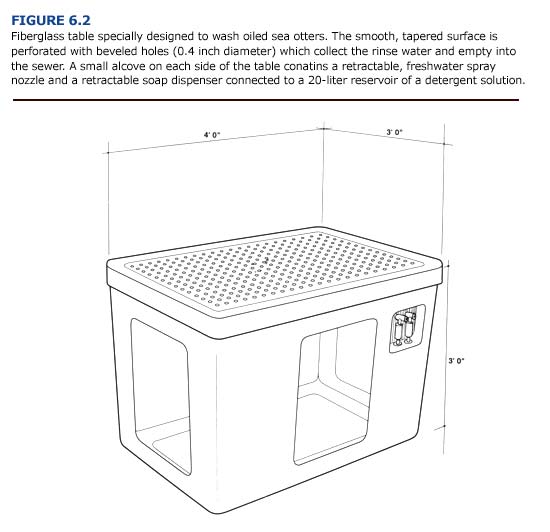
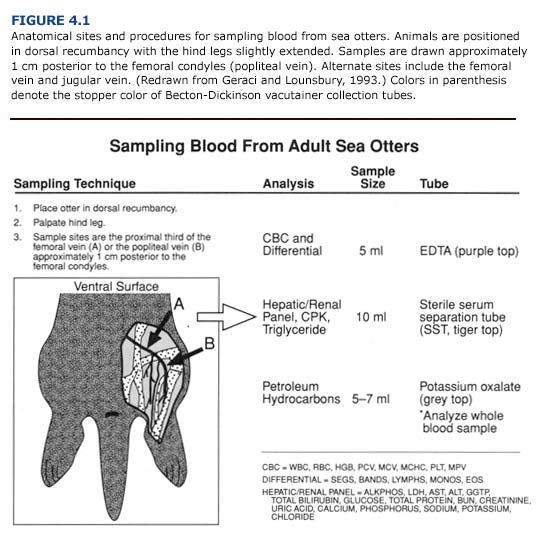
Washing
At least two people are needed to apply detergent and wash the oiled fur. Multiple applications of a solution of DawnTM dish washing detergent (diluted 1:16 in water) are used. The detergent is gently massaged into the oiled fur and then rinsed off with fresh water under moderate pressure (30-40 psi; I psi = 6.89 kPa) with a spray nozzle. Avoid getting detergent in the otter’s eyes, nose, mouth, and ears. Four to eight liters of the detergent solution are normally required. Washing should continue for at least forty minutes or until there is no indication of oil in the rinse water and no odor of petroleum on the fur. Heavy oiling, weathered oil, or the presence of tar balls on the fur may prolong the process. A final forty minute rinse with a spray nozzle is essential to thoroughly remove the detergent and help restore the fur’s water repellency (Williams et al., 1988). Water with a high calcium concentration (hard water) should be demineralized with a commercial water softener before rinsing. As the detergent is rinsed out, the fur will become visibly water repellent (Figure 6.1).

During sedation and cleaning, the core temperature of the otter should be monitored continuously using a digital, electronic thermometer with the flexible probe inserted fifteen cm into the rectum. A decrease in core temperature may occur during cleaning and may be corrected by adjusting the temperature of the rinse water (normal range 28-32°C or 82-90°F). The ambient air temperature in the cleaning room should be 15-20°C (60-68°F). If the otter begins to overheat, decrease the temperature of the rinse water or place bags of crushed ice on the otter’s hind flippers.
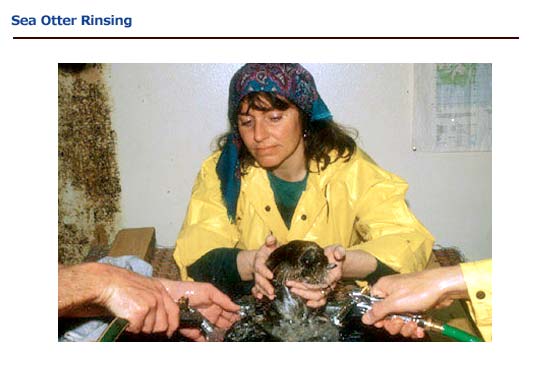
Drying
After the otter’s fur is thoroughly cleaned and rinsed, it should be dried in a dehumidified room. Drying will help restore the insulating air layer within the fur. Because the otter’s fur acts like a sponge, drying a newly cleaned sea otter can be difficult. Absorbent paper towels or clean, cotton towels work best initially. As the towels become moist, they should be replaced with clean, dry ones. When the bulk of the water has been absorbed, the hair should be dried with commercial pet blow dryers set at room temperature or 20°C (68°F).
VideoInsulationThumb.jpg
Application of Conditioners
Detergent not only removes petroleum hydrocarbons from the otter’s fur, it also removes most of the natural sebum from the skin and sebaceous glands (Williams et al., 1988). As a result, the rate of sebaceous secretion and the concentration of sebum (primarily squalene) in the fur may not return to normal for more than one week (Davis et al., 1988). The importance of sebum in maintaining water repellency ad the insulating quality of the fur is uncertain. However, the application of squalene in a volatile silicone and ethanol carrier may accelerate the restoration of the fur. A squalene formula developed by one of the authors (L.H.) and the Hair Care Laboratory at Redkin Laboratories (Canoga Park, CA) contains the following ingredients:
Ingredient % --------------------------------------------- squalene 2.0 glycerol oleate 0.1 super sterol ester (Croda) 0.1 cymethicone (Dow Corning 245 fluid 57.8 alcohol SDA-40 (200 proof) 40.0
Up to 50 ml of the squalene formula is sprayed evenly onto the otter during drying and massaged into the fur by hand. The ethanol is soluble in water and penetrates the wetted fur. Both solvents are at least as volatile as water and, therefore, facilitate complete drying while coating the fur with squalene. The use of conditioners is still experimental and an optional step in the cleaning process.
Recovery from Sedation
After cleaning, drying, and conditioning the fur, the otter should be placed in a cage in the critical care room (see Chapter 12) and allowed to recover from sedation. During this time, the otter’s core temperature should be monitored. Hypothermia or hyperthermia should be treated immediately, as described in Chapter 5. After recovery from the sedative, the otter should be offered small blocks of ice to eat. Chewing on ice appears to relieve stress and will prevent dehydration. Food should also be offered. Once the otter exhibits a stable core temperature, is eating, and shows signs of a normal grooming behavior, it should be moved to a larger pen with a small seawater pool (Chapter 7).


